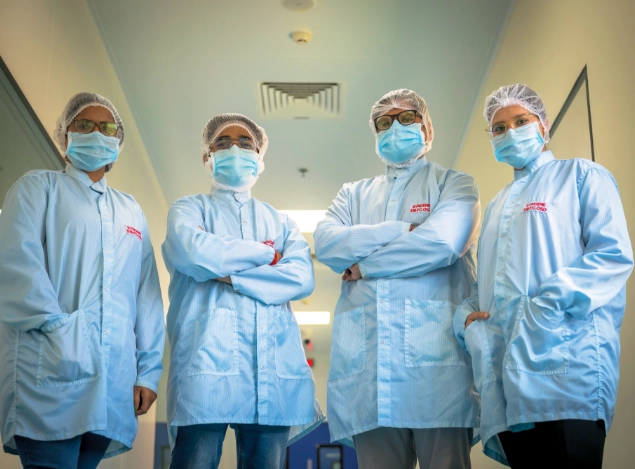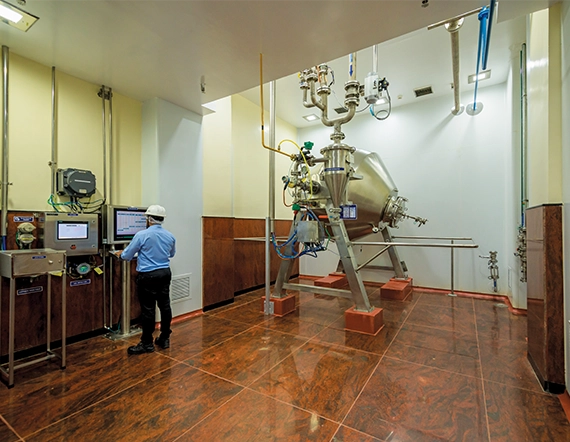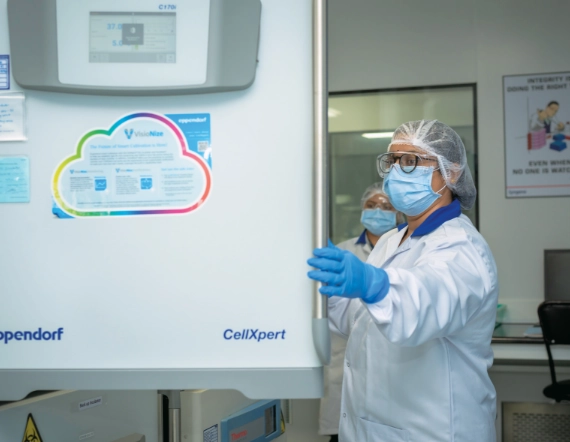
In 2023, the global human pharmaceuticals market by revenue was valued at USD 1.5 Tn and is forecast to grow at a 6% compound annual growth rate (CAGR) over the next five years, reaching USD 2.0 Tn1. The animal drugs market is expected to grow at a similar rate of approximately 6% over the next five years, increasing from USD 48 Bn in 2023 to around USD 65 Bn in 2028's2. More than 90% of Syngene’s revenue is driven by the pharmaceutical segment. As the pharmaceutical market expands, the demand for outsourced research, development and manufacturing to third-party vendors will rise driven by the increasing complexity of therapies and the emergence of small and medium-size biopharmaceutical companies.

The global pharma contract research development and manufacturing organization (CRDMO) industry was pegged at ~USD 107 Bn in 2023. As part of this, the CRO industry was valued at ~USD 25 Bn and the CDMO market (small molecule and biologics) was valued at ~USD 82 Bn. Going forward, the CRO industry is expected to grow at ~13% CAGR, while the CDMO industry growth is expected to accelerate to ~15% CAGR over 2023‑28, implying ~15% growth for the overall CRAMS/CRDMO industry over the same period.
In the following section, we analyze the key trends shaping the CRDMO landscape and their impact on our operations.
1 Frost and Sullivan prescription drugs sales
2 Zoetis Company website and presentations
Over the past decade, global pharmaceutical market revenue grew at a CAGR of 4%, while R&D spending surged ahead at a 7% CAGR3. Big pharmaceutical companies recorded a 6% CAGR in R&D spending, with nearly a 50% increase over the last 5 years alone from USD 115 Bn in 2018 to USD 168 Bn in 20234. The global R&D landscape remains robust with over 5,500 pharmaceutical companies actively engaged in building R&D pipelines as of 2023, featuring over 21,000 drugs5. As research activity continues to rise, the demand for outsourced services remains strong. Moreover, big pharmaceutical companies have increasingly embraced outsourcing in the wake of the pandemic, recognizing the benefits of externalizing their innovation efforts during site lockdowns.
Our advanced scientific capabilities, state-of-the-art infrastructure and world-class quality standards position us as a trusted partner for providing innovative R&D solutions. Our commitment to consistently deliver reliable services to our clients has laid solid groundwork for establishing strategic collaborations. As we continue investing in new technologies and modalities while also driving digitization and automation across our operations, we anticipate benefiting from the ongoing trend of pharmaceutical sponsors seeking to outsource their R&D projects, especially to agile partners. Overall, Syngene services around 400 clients including 14 out of top 20 big pharma companies.
The unprecedented funding into the biotechnology sector during the pandemic period (2020/21) significantly boosted outsourcing of research projects. However, changes in the macro-economic environment have prompted a return to normalized levels, leading to a slowdown in outsourcing, particularly for early-stage research services.
This cyclical trend mirror patterns observed over the last two decades, with peaks and troughs around a long-term upward trajectory. Despite this normalization, biotechnology funding remains robust, with 2023 levels comparable to pre-pandemic figures from 2019 and exhibiting a long-term CAGR of 6%. While 2022/23 has been challenging for biotech funding, Jan to March 2024 funding levels were the highest in previous 14 quarters, similar to funding levels in 2020/21. While the sustainability of the recovery in biotech funding remains uncertain, the growth over the long term indicates that biotechnology could be one of the most attractive investment destinations for capital, with a trajectory that has accelerated over the last decade.
The recent slowdown in biotechnology funding dampened the demand for CRO services, impacting our Discovery Business in FY24. While this challenging financing landscape predominantly affects smaller biotechnology companies in the US, major pharmaceutical firms in the US, Europe, and UK remain relatively shielded, ensuring sustained demand from these clients. Despite the short-term downturn, the long-term industry fundamentals for our Discovery Business remain robust. We anticipate stabilization in demand growth from small- and medium-sized biotechnology clients based in the US from second half of FY25, as the funding environment normalizes, the initial signs of recovery are already emerging.
3 Capital IQ
4 Capital IQ and company filings
5 https://www.statista.com/topics/6755/pharmaceutical-research-and-development-randd/#topicOverview
6 Analyst reports

The pandemic underscored the fragility of supply chains prompting the pharmaceutical industry to prioritize dual sourcing and supply chain diversification for enhanced resilience. Against this backdrop, India has emerged as a favored outsourcing destination, attributed not only to cost advantages but also supportive government policies. Additionally, India boasts a rapidly expanding network of world-class infrastructure and a robust pool of highly qualified scientists proficient in English, empowering Indian CROs to innovate and deliver value-added services beyond mere cost arbitrage.
As a leading player in the Indian market with extensive partnering capabilities and almost three decades of industry experience, India’s increasing attraction as a sourcing destination presents a significant opportunity for our organization. Our ability to efficiently deliver world-class scientific solutions remains central to our value proposition. Moreover, our strategic presence in talent-rich cities like Bangalore and Hyderabad ensures a steady influx of skilled resources to support our growing operations. Our ongoing investments in cutting-edge capabilities and capacity expansion reinforce our commitment to meeting evolving client needs.
In today’s landscape, sponsor companies are gravitating towards integrated service providers for their research, development, and manufacturing needs, seeking to consolidate their outsourcing efforts rather than engaging multiple vendors. Embracing an end-to-end collaboration model facilitates seamless technology and knowledge transfer, expedites time to market and enables greater control over projects. The collaboration, coupled with the outsourced partner’s expertise in navigating regulatory frameworks, minimizes the risk of compliance setbacks.
As an outsourcing partner offering both CRO and CDMO capabilities, we are strategically positioned to capitalize on the growing demand for integrated services. Our continued focus on building expertise across the value chain, from research through to development and manufacturing, is enabling us to provide comprehensive support to clients, facilitating seamless molecule lifecycle management and speed to market. Further, our integrated CRDMO approach aligns closely with the value chain of our clients, fostering synergy and resilience within our business. Additionally, we are leveraging fit-for-phase drug development and manufacturing strategies to shorten the make-test cycles and enhance our position as strategic partners.
The global pharmaceutical market for human health is shifting towards large molecule drugs and expected to grow at a 12% CAGR from 2022 to 2026, contrasting with 2% for small molecules7. This shift is driven by the expanding biologics pipeline, evident in the rise of biologics’ FDA approvals from 32% in 2021 to 37% in 2023. Consequently, demand for biologics manufacturing capacity is rising at a 9% rate, but only 2% will be met by in-house expansions8. Moreover, while emerging biopharmaceutical companies dominate the R&D pipeline, they often lack the infrastructure and in-house capabilities for development and commercialization, leading to a heightened reliance on outsourcing for these services.
Our regulator-approved infrastructure and capabilities position us to meet the growing demand for biologics CDMO services. The recent acquisition of a biologics manufacturing facility, featuring 20,000 liters of installed biologics drug substance manufacturing capacity and a high-speed commercial-scale fill-finish unit, further strengthens our position as a leading biologics CDMO service provider. This facility is scheduled to commence operations in second half of FY25, following completion of facility upgrades and validation.
Enacted in 2022 and effective from 2026, the IRA aims to curb healthcare costs in the US and including through price negotiations for small molecule drugs within US Medicare. While the implications of this Act are still unclear, the legislation will prompt a shift in R&D portfolio priorities for pharma companies, potentially reallocating budgets towards non-small molecule drugs. The difference in the protected economic return period between small molecule drugs and biologics may drive adjustments in investment strategies within the industry’s R&D pipelines. Additionally, the IRA’s effect on the economics of small molecule manufacturing may lead to an increase in outsourcing, especially when additional capital investment for small manufacturing by pharma companies is required.
With the implications of the IRA still uncertain, we are closely monitoring the situation. Nonetheless, we have confidence in our twin-engine strategy, which emphasizes both research services and development and manufacturing services, and in our capability of partnering across both small and large molecules. This approach reinforces our standing as a comprehensive partner, providing resilience to navigate potential shifts in client demands and industry dynamics.


7 Frost and Sullivan prescription drugs sales
8 Bernstein – Global CDMOs: Biomanufacturing supply-demand estimates